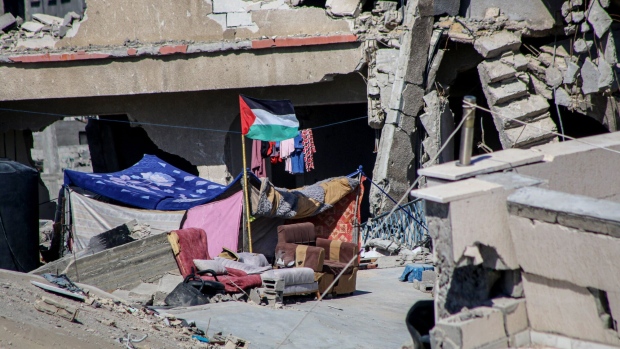May 12, 2024
Gazans Flee Dangers of Rafah for Uncertainty of Jam-Packed Camps
, Bloomberg News

(Bloomberg) -- This is the fourth time Soha Abu Omara and her family have been forced to flee the fighting in Gaza. At least they have a tent.
Seven months into the war between Israel and Hamas, chaos is rising, and so are prices. A tent, the most basic shelter, can cost $1,000. A ride from the southern city of Rafah, now in Israel’s crosshairs, to the declared safety zone of al-Mawasi can be $270. It used to cost about $13. And those who are fleeing jam-packed Rafah find the al-Mawasi safe zone itself overcrowded and squalid — and perhaps not even safe from fighting.
“There are no suitable washrooms, and we stay on the sand and the dust,” Abu Omara said.
At least 300,000 Palestinians have left Rafah since Monday, according to the Israeli military, which warned people to flee before an expected assault aimed at Hamas’ top leaders, thousands of remaining fighters, and tunnels thought to be used to smuggle goods from Egypt. Also believed to be in the area are about 130 Israeli hostages held by Hamas since October. Israel says it’s taking care to avoid civilian casualties in an operation strongly opposed by the US and other allies.
The Israeli military on Saturday ordered more evacuations from the central parts of Rafah, signaling its intention to expand the military operation, including into the city’s downtown.
Palestinians and aid groups say that after so much destruction, nowhere in Gaza is safe — and that the coastal enclave of al-Mawasi is ill-equipped to cram in hundreds of thousands more people.
“How can this huge population, including those with mobility impairments, be moved on destroyed roads, in areas polluted by weapons?” said Hisham Mhanna, a spokesman for the International Committee of the Red Cross. “Are these areas equipped with what is needed to ensure the families’ survival? Will food, water, medicine, health care, and above all, security and safety, be provided?”
The plight of Palestinians has inflamed tension between Israel and the US, its most important ally. US officials still haven’t seen a “clear, credible plan” from Israel for protecting civilians in densely populated areas such as Rafah, Secretary of State Antony Blinken said Sunday.
Read more: Biden Warns He’d Delay More Weapons If Israel Attacks Rafah
“Second, we also need to see a plan for what happens after this conflict in Gaza is over,” he said on CBS’s Face the Nation.
According to UN agencies, the relocation sites lack essential facilities such as proper latrines, water access points, drainage systems, and adequate shelter.
The war began on Oct. 7, after militants from Hamas, considered a terrorist organization by the US and European Union, stormed into southern Israel from Gaza, killing 1,200 people and taking 240 hostages. Since then, Israeli attacks have killed more than 35,000, according to the Hamas-run health ministry. Israel, which hasn’t offered a total death estimate, says it’s killed some 13,000 fighters.
Al-Mawasi is a formerly barren patch of coast and dunes in southwestern Gaza which Israel designated a “humanitarian area” after the war began, telling residents fleeing the fighting in the north to go there.
Since Oct. 7, more than 70% of Gaza’s housing stock has been destroyed, according to the UN. And so a black market for shelter has emerged. Tents donated to Palestinians by several Gulf countries like the United Arab Emirates, Kuwait and Qatar, as well as international organizations like the Red Crescent, are being resold for sky-high prices that most Gazans can’t afford.
After the recent evacuation orders around Rafah, crowds raided warehouses belonging to aid organizations and the Hamas-run social affairs ministry. They grabbed tents and other supplies, further exacerbating the situation and spreading chaos.
Some leaving Rafah returned to Khan Younis, a city from which Israeli forces withdrew in April after weeks of operation, leaving behind extensive destruction. Residents sought shelter under the damaged roofs of their old homes, or set up tents amid shattered cinder blocks and twisted rebar.
The UN Relief and Works Agency for Palestine Refugees, or UNRWA, says people have also attempted to return their children to schools in Khan Younis, only to find the “classrooms are torched,” the group said on X. “Walls are blown out. There is rubble everywhere.”
Asmaa Arafat has housed about 20 members of her extended family at her home in Rafah. For nearly seven months, Arafat, 47, has lived with her children and other displaced people, enduring food, gas, electricity and water shortages as well as the constant fear of Israeli bombardment.
After Monday’s warning, “We collected our belongings and prepared to leave,” Arafat said in a phone interview, “but we couldn’t find a means of transportation.”
Despite the challenges, tens of thousands have left by foot, animal-pulled carts or vehicles in recent days, carrying essential belongings like mattresses, blankets and water containers. There was no clear guidance from local authorities, and little assistance was provided. By Saturday, east Rafah was deserted and the downtown largely abandoned, days after shells started landing there and before Israel included the heart of the city under evacuation orders.
Arafat’s family and guests decided to hold out for one more day, but artillery shells started falling on the neighborhood in the late afternoon. The Israeli warnings, published on social media and relayed by phone calls, text messages and air-dropped leaflets, gave no timeline for the evacuation. “It was a night of hell,” she recalled. “We didn’t believe we would be alive by the morning.”
The next day, a truck driver demanded $270 for the ride to al-Mawasi - but the family has run out of money. “We split up,” she said. “My daughter and I walked west to her husband sister’s house, and my family returned to their damaged houses in Khan Younis.”
--With assistance from Tony Czuczka.
(Adds Blinken comments starting in eighth graf.)
©2024 Bloomberg L.P.


